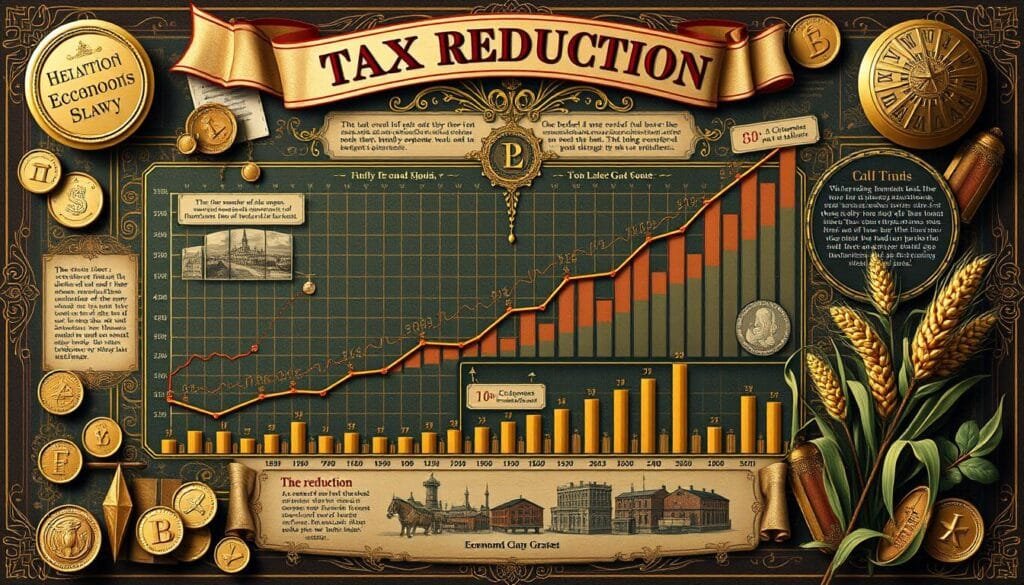Tax policy plays a crucial role in economic growth. Studies show that lowering taxes can boost the economy. This happens because tax cuts encourage people to spend and invest more. However, this topic has many layers. Tax cuts that promote savings, jobs, and investments can lead to growth. But we must also consider the effects on government spending and debt.
Mertens and Olea’s research (2018) shows a 1% tax cut could increase GDP by 0.78% after three years. Zidar (2019) found that lower taxes for most people help the economy and jobs a lot. These findings highlight the power and complexity of tax policies.
Looking at past and present tax policies helps us understand their impact. Insights from places like the U.S. Chamber of Commerce show how taxes can drive growth. With careful use, tax policy can lead to widespread economic benefits. Yet, we must carefully balance growth with financial health as we plan for the future.
Key Takeaways
- Economic expansion relies on smart tax policy, where incentives are key.
- Studies show that tax rate cuts can greatly improve GDP and benefit society.
- Growth over the long term depends on avoiding increased government debt.
- The success of tax cuts as a stimulus depends on how they are planned and applied.
- Reforming taxes to broaden the tax base could lead to better resource use and a bigger economy.
- Combining targeted tax cuts with strict financial control is vital for sustained growth.
Understanding the Mechanics of Tax Reduction
Tax reduction and economic expansion are closely linked, affecting everything from personal finances to overall growth. By examining how these cuts affect different areas, we understand their impact on the market and people’s money management.
How Tax Cuts Influence Consumer Behavior
Lowering taxes shapes how people handle their finances. When taxes go down, people have more money to spend and save. Specifically, less income tax boosts buyers’ power, increasing demand for products and services. This encourages more economic activity.
The Role of Tax Policy in Encouraging Investment
Tax policies, like cuts, push for stronger investment drives. Lowering taxes on earnings encourages businesses to spend more on growth and new ideas. This helps a company grow and boosts the economy by creating jobs and new chances to invest.
Immediate vs. Long-Term Economic Impacts of Reduced Tax Rates
In the beginning, tax cuts can boost the economy by raising spending and investments. Yet, their long-term effect varies based on how the government handles the bigger deficits. If cuts lead to more borrowing, this might push up interest rates. High rates can slow down growth by limiting investments.
The recent data give us a closer look at these effects:
| Year | Individual and Estate Trust Income Tax (trillion) | Employment Tax (trillion) | Corporate Tax (billion) | Excise Tax (billion) |
|---|---|---|---|---|
| 2023 | $2.56 | $1.57 | $456.94 | $74.25 |
This financial data lets us see the major impacts of tax cuts on different parts of the economy. This shows the strong link between tax policies and the market’s vitality.
Historical Analysis of Tax Reductions and Economic Growth
The tax reform history of the United States shows big changes to boost the economy. These changes reduced taxes mainly for those with high incomes. By looking at historical tax rates, we can see how tax laws changed and their effect on the GDP.

Understanding the role of tax cuts is key. For example, tax cuts under Ronald Reagan and John F. Kennedy aimed to strengthen the economy. The results varied.
Under Reagan, the 1980s saw tax revenues jump by 99.4 percent. Personal income tax money alone went up by more than 54 percent by 1989. After adjusting for inflation, this was a 28 percent increase.
During Kennedy’s time in the 1960s, tax revenues went from $94 billion in 1961 to $153 billion in 1968. This was a 62 percent boost, or 33 percent after inflation adjustment.
In the 1920s, though tax rates were cut, revenues still rose from $719 million in 1921 to $1164 million in 1928. This was an increase of over 61 percent.
These figures show that tax cuts can lead to more revenue at first. Yet, the long-term effect on GDP isn’t as clear. This shows a complicated link between tax laws and economic growth. Growth isn’t always guaranteed after a tax cut.
In a wider view, studying fiscal conservatism into the 1950s and later shows an interesting trend. Even with a corporate tax rate drop from over 50% to 35%, GDP impact has been minor. This hints at other factors influencing economic growth beyond just tax changes.
So, while tax cuts are often seen as a way to boost the economy, their real effects are more complex. Looking closely at these patterns can guide future tax policies. It helps us understand their true impact on the economy and fairness in society.
Is tax reduction going to stimulate economic growth
Exploring tax reduction benefits shows they might boost economic stimulation. Tax policy is key in shaping the economy. But, the impact of tax cuts on long-term growth isn’t clear. It depends on the policy details.
The Federal Reserve cut its key lending rate by 100 basis points after national crises. This move, along with a $40 billion package for defense and a $5 billion airline bailout, shows how complex fiscal strategies are.

Top economists like Alan Greenspan suggest a budget over $50 billion for crisis recovery. Adjusting tax rates, especially for the wealthy, raises questions about fairness and impact.
Tax cuts can temporarily boost spending—a minor 0.2% rise after a 1.9% increase in income. But, people might only spend 20% to 70% of tax cut benefits. So, the role of tax cuts in long-term growth is not clear.
Cutting taxes on profits or businesses may pose risks, like higher interest rates harming growth. These complex issues make it important to rethink tax policies. We should aim for strategies that offer both immediate and lasting benefits.
Developing tax cuts that truly drive growth is tough due to the complexities of economics. Merging solid evidence with wise strategy is essential for creating effective tax policies. This approach can lead to meaningful economic stimulation.
Evaluating the Impact of Tax Reduction on Employment Rates
Policy makers and economists study tax policies and their effects on jobs. They focus on how tax changes impact employment. This gives insights into the economic health of a country.
Correlation Between Lower Taxes and Job Creation
Lower taxes have a complex effect on jobs. They can lead businesses to grow and create jobs. The Tax Cuts and Jobs Act of 2017 aimed to boost the economy by lowering corporate taxes.
Despite some growth in certain sectors, overall job trends didn’t show big improvements. Middle and lower-income groups didn’t see much change.
Sector-Specific Employment Growth Following Tax Cuts
Tax cuts affect sectors differently. Some industries benefit more than others. Manufacturing often sees more jobs due to more investment after tax cuts.
Service sectors don’t always grow as much. They depend more on consumer demand than on investments.
Tax policy changes also affect jobs indirectly. They influence consumer spending, resource use, and business investment. These factors shape the job market.
In the end, tax cuts can spur growth and jobs, but the effects vary by sector. This shows the need for tax policies that consider different industry needs and overall economic goals.
| Sector | Pre-Tax Cut Employment Rate | Post-Tax Cut Employment Rate | Change |
|---|---|---|---|
| Manufacturing | 72% | 76% | +4% |
| Services | 80% | 81% | +1% |
| Construction | 65% | 69% | +4% |
| Tech | 85% | 89% | +4% |
The Impact of Tax Reduction on Government Budget and Deficits
Understanding how tax cuts affect government money, fiscal health, deficit trends, budgetary effects, and public finance is complex. Tax cuts aim to boost the economy. But, they can majorly impact the government’s budget right away.

In the U.S., there’s a lot of talk about tax cuts. People debate if they can help the economy without harming the government’s money. Recently, tax cuts led to a predicted federal deficit trend. The U.S. budget deficit might reach about $1.9 trillion by 2024.
We must look at these fiscal moves in a wide context. They have long-term budgetary effects we need to understand. Below is a table. It compares the expected money loss from tax cuts to government spending. This shows the financial challenges that may come:
| Fiscal Year | Projected Revenue Loss ($ billion) | Government Spending ($ trillion) |
|---|---|---|
| 2023 | 21.1 | 6.13 |
| 2024 | 57.4 | Projected Increase |
| 2025 | Estimated Increase | Continued Increase |
This table shows a worrying rise in deficit trends. Tax cuts are part of the reason, along with no cut in government spending. If spending isn’t reduced or other income doesn’t rise, the nation’s money health could be at risk.
So, while tax cuts can help the economy grow, we must carefully check their effect. They impact fiscal health and public finance. We need to ensure they don’t hurt our financial future.
Comparative Analysis: Tax Reduction Models in Different Economies
Tax reduction strategies have varying effects worldwide. Developed nations use them to boost economic activities and maintain fiscal health. Meanwhile, emerging markets experience unique challenges with these reforms. This analysis compares different economic models. It highlights how tax strategies affect global economies.
Case Studies from Developed Countries
In places like the US, Canada, and Denmark, tax policy debates are common. Decreasing corporate taxes there has led to investment and growth. This shows that lower corporate taxes boost productivity and innovation, giving countries a competitive advantage globally.
Emerging Markets and Tax Policy Reforms
Emerging markets have different economic bases than developed countries. Their reforms aim at growth and socio-economic stability. For instance, small tax increases can hit the poor hard. This highlights the need for tax strategies that consider each economy’s unique needs.
Lessons Learnt and Applicability
The study of tax reforms across nations reveals important lessons. Firstly, corporate tax cuts usually spur growth. Yet, their success depends on the economy’s state and the sectors targeted. Also, when countries coordinate tax policies, it can boost global economic stability.
Decades of data show how tax policies interact with economic performance. According to the analysis, strategic tax rate reductions support economic recovery. They especially help by creating jobs and encouraging business investments.
| Country | Tax Reduction (% of GDP) | Impact on GDP (% change) |
|---|---|---|
| United States | -0.5 to -1 | Positive |
| Mexico | 17.6 | Negative |
| Sweden | 46.1 | Variable |
| Denmark | 25 | Significant Positive |
This analysis underlines the need for custom tax strategies. It also shows how these strategies have consequences on international policy. By considering these factors, governments can create tax policies that enhance economic results. They can also avoid negative effects on social equity and stability.
Tax Rate Cuts vs. Base Broadening: What Works Better for Economic Growth?
In the debate on boosting economic health, experts differ on rate reduction strategies and tax base widening. Both paths affect fiscal growth efficiency and policy effectiveness differently. Let’s explore how they help the economy grow.
Tax rate cuts aim to quickly rev up economic activities. They’re great during tough times. They leave people and businesses with more money. This can lead to more spending and investments. But, this might not keep the economy growing in the long run. Especially if the tax cuts are big and last too long without balance.
On the other hand, widening the tax base means taxing more types of transactions or entities. It doesn’t mean raising taxes. This method tries to make tax collection fairer while preventing big drops in government money. It’s better for long-term plans but could cut down on what people spend if not handled right.
- Short-term boost vs. sustainable growth: Rate reduction jumps starts the economy; base broadening keeps it healthy over time.
- Impact on government revenue: Cutting rates might reduce government money at first. Broadening the base helps keep money flowing in.
- Effect on taxpayer behavior: Rich folks might get more from rate cuts, making inequality worse. A wider tax base spreads the tax load more fairly.
| Economic Indicator | Rate Reduction Impact | Base Broadening Impact |
|---|---|---|
| Consumer Spending | Increases initially | Varies; could decrease |
| Investment | Increases due to higher capital availability | Mild increase if implemented with corporate tax incentives |
| Income Inequality | May increase | Potentially decreases |
| Long-term Economic Growth | Potentially unsustainable without policy adjustments | More likely sustainable |
In summary, both the rate reduction strategy and tax base widening have strengths and weaknesses. Mixing these methods might be the best way to achieve solid fiscal growth efficiency and policy effectiveness. This mix offers the quick boost of cuts and the lasting benefits of a fair tax system.
Prospects and Risks: Future of Tax Policy and Economic Expansion
Right now, we’re at a critical point where the mix of taxation and growth outlook is key. We need policies that are forward-looking but flexible. They should boost the economy and be sustainable over time.
Navigating the Balance: Tax Cuts and Sustainable Growth
It’s vital to find a balanced tax policy that fosters growth yet keeps budgets in check. Studies show tax cuts can spur the economy. But, their long-term impact depends on how they fit with overall economic plans. The Tax Cuts and Jobs Act boosted deficits but changed corporate taxes. This could influence how businesses invest.
Also, facing global economic challenges, we need to rethink our tax approach for growth optimization. Looking back, the US outgrew Europe in the 1990s through quick policy changes. This led to faster growth and more investment in the US.
Policy Recommendations for Maximizing Growth Through Taxation
To boost economic growth via taxation, we need policies that are ahead of the curve. Simplifying tax codes, encouraging new sectors, and keeping taxes competitive are essential. Policies must be scalable and adaptable, allowing them to evolve with the economy.
It’s also crucial to ensure tax reforms are fully paid for to avoid deficit issues, as seen after the Tax Cuts and Jobs Act. This strategy strengthens the economic foundation. It supports ongoing expansion and innovation.
In conclusion, navigating towards a future full of unknowns and potential, the right tax policy is crucial. It’s about balancing short-term boosts with long-term economic health. This balance is central to our tax policy goals.
Conclusion
Economic growth analysis shows that tax policy is complex. Over the years, fiscal reforms aimed to boost the economy. But, the effects were mixed. In the 1980s, despite lower tax rates, the expected income boost didn’t happen. Instead, high top income taxes may lead to better economic growth, according to Emanuel Saez’s research.
The 2017 Tax Cuts and Jobs Act hoped to increase investment and wages. Yet, it mainly benefited shareholders, making wealth inequality worse. These results show we should judge policy by its actual impacts, not intentions alone. Also, national savings decreased after tax cuts, which wasn’t expected.
Comparing with countries like Canada and Japan, we see they cut corporate taxes to help growth. These cuts have helped with capital formation and economic growth. Still, we must plan tax reforms carefully to avoid creating deficits. Policymakers need to find a balance for immediate and long-term economic health.
FAQ
How can tax reduction foster economic growth?
Tax reduction helps the economy grow by giving financial perks. This encourages people and companies to work, save, invest, and spend more. With more money after taxes, these activities might boost the economy.
How do tax cuts influence consumer behavior?
Tax cuts increase disposable income, so people might spend, save, or invest more. This can quickly boost the economy. The lasting impact depends on supporting fiscal policies.
What is the role of tax policy in encouraging investment?
Tax policy boosts investment by offering perks like lower taxes on gains, dividends, and interest. This reduces capital costs and encourages economy-boosting investments.
Are there immediate vs. long-term economic impacts of reduced tax rates?
Tax cuts can spark short-term economic activity by increasing liquidity. Yet, long-term effects rely on funding methods and potential deficit increases, which may hinder growth.
How has historical tax reform impacted GDP?
Past tax reforms have influenced GDP growth differently. Some reforms aimed to boost the economy through higher consumption and investment. Yet, their long-term GDP impacts vary based on implementation and effects on deficits.
Can tax reduction stimulate economic growth?
Tax reduction can boost growth when combined with a strategic fiscal approach. It’s important that tax cuts encourage new activities and avoid only benefiting previous ones.
Is there a correlation between lower taxes and job creation?
Studies link lower tax rates to job creation, which may lower unemployment and grow the economy. But, impacts differ across income groups and sectors, showing tax policy’s complex effects on jobs.
What is the impact of tax reduction on government budget and deficits?
Tax cuts can widen government deficits if spending doesn’t drop, risking long-term economic well-being and possibly requiring future tax hikes.
How do tax reduction models differ in developed and emerging economies?
Developed economies focus tax cuts on spurring innovation and investment, with mixed results. Emerging economies’ tax reforms also tackle inequality while aiming for growth, taking local conditions into account.
What’s more effective for economic growth: tax rate cuts or base broadening?
Tax rate cuts and base broadening have different impacts. Cuts can offer quick benefits but may raise long-term challenges without spending cuts. Broadening makes the tax system efficient, potentially driving growth but might increase effective rates, reducing incentives.
How can we navigate the balance between tax cuts and sustainable growth?
Balancing tax cuts and growth requires fiscal responsibility and considering long-term tax cut impacts. Policies should motivate economic activity but avoid creating unsustainable deficits.
What are the policy recommendations for maximizing growth through taxation?
Officials should create tax reforms that encourage work, savings, and investment. They should also minimize distortions, focus on new activities, and keep an eye on fiscal health to avoid deficit-funded growth.
